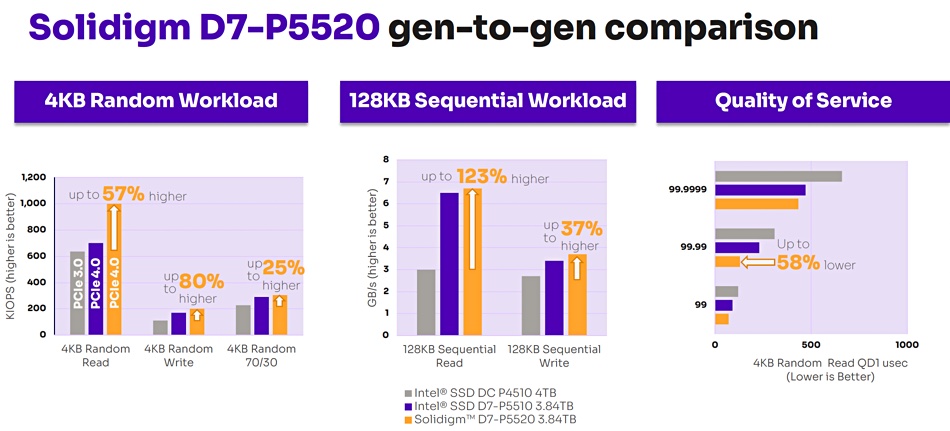Solidigm has upgraded its PCIe 4 datacenter SSDs to faster models using denser 3D NAND chips.
Update: Solidigm performance numbers updated. 29 April 2022.
Intel’s storage unit first produced D7-P5500 (1 drive write/day) and D7-P5600 (3 drive writes/day) SSDs using 96-layer 3D NAND organised into TLC (3bits/cell) format, with a PCIe 4 x 4 lane interface. When SK hynix bought the unit, it was renamed Solidigm and continued with its Intel-era product branding.
The two new SSDs in the D7 datacenter line are the P5520 and the P5620. Both use 144-layer TLC NAND.
Solidigm’s GM for datacenter products, David Dixon, said in the announcement: “The D7-P5520 and the D7-P5620 are the culmination of these insights and of multiple 3D NAND and PCIe 4.0 generations, which enable us to deliver a best-in-class offering and a new paradigm in solid-state storage.”
The existing PCIe 4-based P5510 is a read-intensive drive supporting up to 1 DWPD and the mixed-use P5610 also up to 1DWPD. The new drives are different with the P5520 being a 1 DWPD product, designed for read-intensive and light mixed workloads, and the P5620, intended for mixed workloads, supporting up to 3 DWPD.
The P5520 capacities and formats are:
- U.2 – 1.92TB, 3.84TB, 7.68TB, 15.36TB
- E1.S 9.5mm, 15mm – 1.92TB, 3.84TB, 7.68TB
- E1.L 9mm – 15.36TB
The P5620 comes in only the U.2 format and has a 1.6TB, 3.2TB, 6.4TB, and 12.8TB capacity range, reflecting its greater over-provisioning need with a mixed-use workload.
Performance picture
A new paradigm? Let’s see. Here are Solidigm-supplied performance charts, with the P5520 compared to the older PCIe 3-based P4510:

The P5620 is compared to the P4610, again PCIe 3-based:

The size of some of these improvements is not surprising as we are comparing P4510 PCIe 3 interface SSDs with PCIe 4, which is twice as fast. How do the new Solidigm SSDs compare with the prior P5500 and P5600, which also use the PCIe 4 bus and were built with 96-layer 3D NAND?

The new products’ maximum read IOPS is ten per cent higher, and the P5520 outputs 70 per cent more random write IOPS than the older P5500.
The sequential bandwidth picture is mixed as well. Sequential reads are a tad faster with the new products: 7.1GB/sec vs 7GB/sec, but sequential writes are a tad slower at 4.2GB/sec vs 4.3GB/sec.
The new products’ latency is worse. The P5500/P5600 delivers latency as low as 9µs read and 12µs write but the newer P5520/P5620 only achieves 75µs read and 15µs write – a substantially slower read latency and slightly worse write latency.
We know that a new Inspur PCIe 4.0 NVMe SSD has 1.5 million random read IOPS and 400K random write IOPS, along with 7GB/sec sequential reads and 5GB/sec sequential writes. Solidigm’s new kit doesn’t really stack up on this basis when compared to Inspur’s product.
Consistency
Solidigm declares that its new drives are designed and tested with zero tolerance for data errors, consistently durable IOPS and QoS, and with near-zero lifetime performance degradation. It wants us to know that the P5520 delivers up to 40 per cent better read responsiveness in the presence of write pressure as compared to the competition – a key consideration, it says, for real-world workloads. It also provides up to 90 per cent IOPS consistency and <0.3 per cent variability over the drive’s life.
One other point: Solidigm says that OEMs designing for a 10 million IOPS 2U server can, by using these drives, reduce their storage footprint up to 27 per cent while lowering power consumption up to 28 per cent compared to the P5510 product.
Solidigm says it already has a customer for the drives: China’s ByteDance, which owns TikTok. It will use the D7-P5520 in its Volcano Engine business public cloud service.








